Themed collection Selenium & Tellurium chemistry at the beginning of the 3rd millennium: a celebration of ICCST

Selenium & tellurium chemistry at the beginning of the 3rd millennium: a celebration of ICCST
Vito Lippolis and Claudio Santi introduce the New Journal of Chemistry themed collection on selenium & tellurium chemistry at the beginning of the 3rd millennium: a celebration of ICCST.

New J. Chem., 2019,43, 11032-11033
https://doi.org/10.1039/C9NJ90092F
Reactivity of hemi-labile pyridyl and pyrimidyl derived chalcogen ligands towards group 10 metal phosphine precursors
The reactivity of N-heterocyclic dichalcogenides and their sodium salts towards group 10 metal phosphine precursors has been investigated.

New J. Chem., 2020,44, 2689-2696
https://doi.org/10.1039/C9NJ04993B
Ring opening reactions of heterocycles with selenium and tellurium nucleophiles
An overview of the preparation and synthetic potentialities of functionalized organoselenium and organotellurium compounds is presented.

New J. Chem., 2019,43, 11451-11468
https://doi.org/10.1039/C9NJ02320H
Pyridyl and pyrimidyl chalcogenolates of coinage metals and their utility as molecular precursors for the preparation of metal chalcogenides
Synthesis of and metallophilic interactions in N-heterocyclic chalcogenolates of coinage metals have been described and their utility as molecular precursors for binary and ternary chalcogenide materials has been demonstrated.

New J. Chem., 2019,43, 11034-11040
https://doi.org/10.1039/C9NJ02769F
1,4-Anhydro-4-seleno-D-talitol (SeTal): a remarkable selenium-containing therapeutic molecule
1,4-Anhydro-4-seleno-D-talitol is an exceptional selenium-containing small molecule with significant therapeutic potential; its beneficial actions firmly establish a new therapeutic paradigm in which selenium plays a central role.
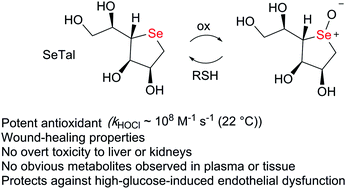
New J. Chem., 2019,43, 9759-9765
https://doi.org/10.1039/C9NJ02185J
Organoselenium small molecules as catalysts for the oxidative functionalization of organic molecules
This perspective highlights the critical analysis of the challenges, in the past decade, which led to the development of organoselenium compounds and their use as versatile catalysts in organic synthesis towards the oxidation of olefins and C–H bonds. Furthermore, the emphasis here differs from previous reviews of the field by classifying the various types of catalyses and the diverse strategies.
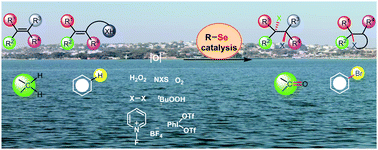
New J. Chem., 2019,43, 8852-8864
https://doi.org/10.1039/C9NJ00964G
Adaptive responses of sterically confined intramolecular chalcogen bonds
The existence of intramolecular chalcogen bonds (IChBs) in 2,6-disubstituted arylchalcogen derivatives is determined by the substituents and the sigma hole donor behavior of the chalcogen atom in the molecule.
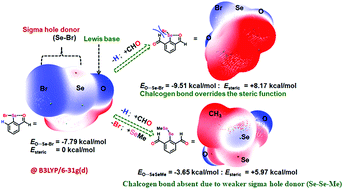
Chem. Sci., 2018,9, 7027-7042
https://doi.org/10.1039/C8SC01943F
Developments in the chemistry of the hard early metals (Groups 1–6) with thioether, selenoether and telluroether ligands
Key developments in the coordination chemistry of the soft, neutral chalcogenoether ligands towards hard s-, f- and early d-block ions, and their prospects for various applications are discussed.
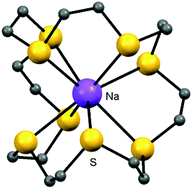
Dalton Trans., 2016,45, 18393-18416
https://doi.org/10.1039/C6DT03409H
PCP-bridged chalcogen -centred anions: coordination chemistry and carbon-based reactivity
Multidentate chalcogen-centred ligands, whose flexibility and redox-activity is manifested in their metal complexes, are generated from bis(chalcogenophosphinoyl) C-bridged anions via selenium–proton exchange or direct reaction with chalcogens.

Dalton Trans., 2012,41, 4283-4295
https://doi.org/10.1039/C2DT12361D
Palladium-catalysed direct thiolation and selenation of aryl C–H bonds assisted by directing groups
Recent advances on transition-metal-catalyzed direct chalcogenation of C–H bonds with disulfides and diselenides are summarized.
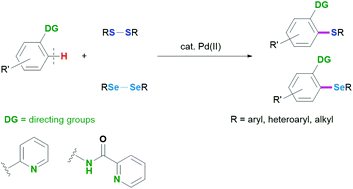
Dalton Trans., 2016,45, 15278-15284
https://doi.org/10.1039/C6DT02167K
Biology and toxicology of tellurium explored by speciation analysis
Recent advances in the speciation and identification of tellurium metabolites in animals and plants by LC-ICP-MS and LC-ESI-MS are reviewed.
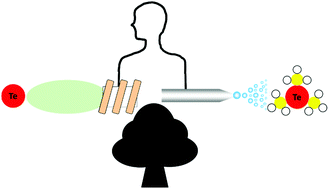
Metallomics, 2017,9, 435-441
https://doi.org/10.1039/C7MT00022G
Marriage of heavy main group elements with π-conjugated materials for optoelectronic applications
This review showcases recent work devoted to placing heavy inorganic elements within π-conjugated frameworks and the novel properties that can arise.
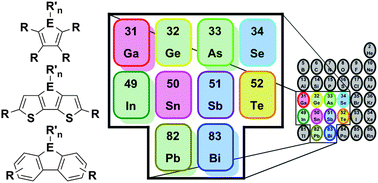
Chem. Commun., 2016,52, 9485-9505
https://doi.org/10.1039/C6CC04023C
“The green side of the moon: ecofriendly aspects of organoselenium chemistry”
Key aspects for the development of a greener synthesis and the use of the organoselenium compounds.
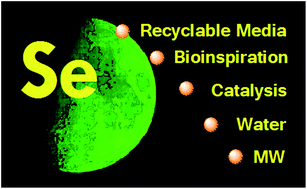
RSC Adv., 2014,4, 31521-31535
https://doi.org/10.1039/C4RA04493B
Tellurium: a maverick among the chalcogens
This tutorial review elucidates the fundamental concepts necessary for an understanding of the unique structures and reactivities of tellurium compounds.
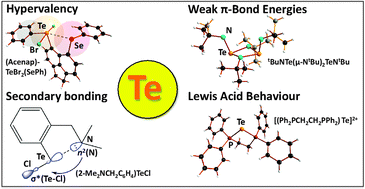
Chem. Soc. Rev., 2015,44, 1725-1739
https://doi.org/10.1039/C4CS00434E
The single molecular precursor approach to metal telluride thin films: imino-bis(diisopropylphosphine tellurides) as examples
Pure thin films of metal tellurides, such as CdTe, Sb2Te3 and In2Te3, can be generated from complexes of the [TePri2PNPPri2Te]− ligand by using the technique of aerosol-assisted chemical vapour deposition.
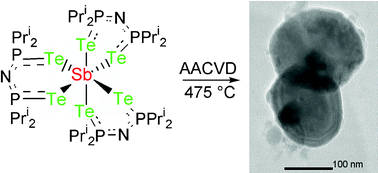
Chem. Soc. Rev., 2007,36, 1622-1631
https://doi.org/10.1039/B605535B
Synthesis of selenocysteine-containing cyclic peptides via tandem N-to-S acyl migration and intramolecular selenocysteine-mediated native chemical ligation
Cyclic selenocysteine-containing peptides were synthesized via one-pot tandem conversion of N-alkylcysteine-containing selenopeptides.
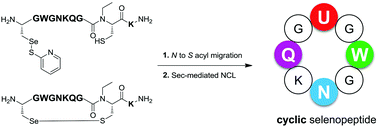
Chem. Commun., 2018,54, 11737-11740
https://doi.org/10.1039/C8CC06805D
Visible-light promoted fluoroalkylselenolation: toward the reactivity of unsaturated compounds
α-Fluoroalkylselenolated sulfones have been readily obtained via a visible-light promoted radical addition of fluoroalkylselenyl and tosyl groups onto unsaturated substrates.
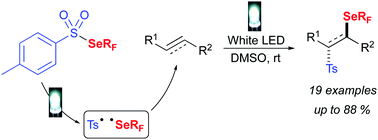
Chem. Commun., 2018,54, 9909-9912
https://doi.org/10.1039/C8CC05256E
Synthesis and antioxidant capacity of novel stable 5-tellurofuranose derivatives
Novel stable tellurium-containing carbohydrates are prepared; these react very rapidly with two-electron oxidants and show promise as protective agents.
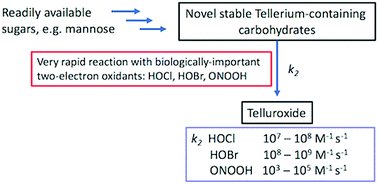
Chem. Commun., 2018,54, 2990-2993
https://doi.org/10.1039/C8CC00565F
Methionine and seleno-methionine type peptide and peptoid building blocks synthesized by five-component five-center reactions
A first example of Ugi 5-component 5-center reactions resulted in methionine and Se-methionine type peptide and peptoid building blocks.

Chem. Commun., 2017,53, 3777-3780
https://doi.org/10.1039/C7CC00399D
A new class of silica-supported chromo-fluorogenic chemosensors for anion recognition based on a selenourea scaffold
The first example of a chromo-fluorogenic chemosensor containing a selenourea moiety is here described.
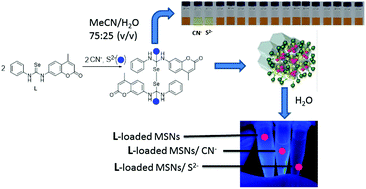
Chem. Commun., 2017,53, 3729-3732
https://doi.org/10.1039/C7CC01214D
A ruthenium tellurocarbonyl (CTe) complex with a cyclopentadienyl ligand: systematic studies of a series of chalcogenocarbonyl complexes [CpRuCl(CE)(H2IMes)] (E = O, S, Se, Te)
The first tellurocarbonyl complex with a half-sandwich structure [CpRuCl(CTe)(H2IMes)] was synthesized and compared with its CE (E = O, S, Se) analogs.
![Graphical abstract: A ruthenium tellurocarbonyl (CTe) complex with a cyclopentadienyl ligand: systematic studies of a series of chalcogenocarbonyl complexes [CpRuCl(CE)(H2IMes)] (E = O, S, Se, Te)](/en/Image/Get?imageInfo.ImageType=GA&imageInfo.ImageIdentifier.ManuscriptID=C6DT04440A&imageInfo.ImageIdentifier.Year=2017)
Dalton Trans., 2017,46, 44-48
https://doi.org/10.1039/C6DT04440A
Permanently porous hydrogen-bonded frameworks of rod-like thiophenes, selenophenes, and tellurophenes capped with MIDA boronates
Permanently porous hydrogen-bonded organic frameworks comprising rod-like molecules with two MIDA boronate termini have been prepared.
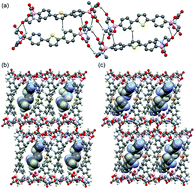
Dalton Trans., 2016,45, 9754-9757
https://doi.org/10.1039/C5DT04960A
Diselenide-based probe for the selective imaging of hypochlorite in living cancer cells
A non-traditional and robust probe skeleton was derivatized for chemosensing applications to investigate a potential novel mode of hypochlorite detection.
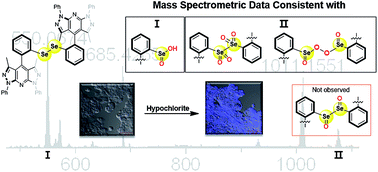
RSC Adv., 2016,6, 32013-32017
https://doi.org/10.1039/C6RA04257K
Sodium and rhodium complexes of a spirocyclic Te5 dianion supported by P2N2 rings
The versatile coordinating ability of a novel spirocyclic, P2N2-supported Te5 dianion is exemplified by N,N′-bonding to Na+ ions and Te,Te′,Te′′ linkages to a Cp*Rh(III) group.

Dalton Trans., 2015,44, 8781-8783
https://doi.org/10.1039/C4DT03257H
Biosynthetic selenoproteins with genetically-encoded photocaged selenocysteines
The first general approach for the biosynthesis of selenoproteins that contain photocaged selenocysteine residues at genetically-encoded positions is described.
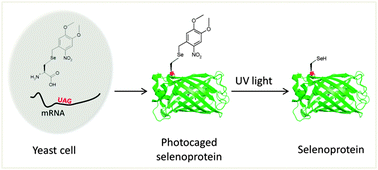
Chem. Commun., 2015,51, 8245-8248
https://doi.org/10.1039/C4CC07910H
Phosphorescence within benzotellurophenes and color tunable tellurophenes under ambient conditions
The zirconium-mediated syntheses of pinacolboronate (BPin) appended benzo[b]tellurophenes and two phenyl/BPin substituted tellurophene isomers with different colors of emission have been achieved.
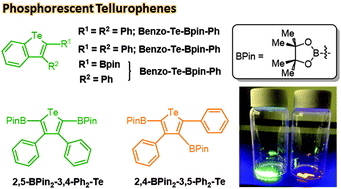
Chem. Commun., 2015,51, 5444-5447
https://doi.org/10.1039/C4CC06529H
Diselenolodiselenole: a selenium containing fused heterocycle for conjugated systems
Diselenolodiselenole (C4Se4) derivatives are synthesized for the first time by heating substituted diaryl diynes with elemental selenium. The optical, electrochemical and structural properties of C4Se4-derivatives are tuned by varying end-capping aromatic substituents.

Chem. Commun., 2014,50, 13454-13456
https://doi.org/10.1039/C4CC05439C
The activation of Woollins' reagent. Isolation of pyridine stabilised PhPSe2
Reaction of Woollins' reagent (WR) with pyridine yields the P(V) species PhPSe2 stabilised by pyridine coordination. Its potential as a selenation reagent under mild conditions was shown by calculations and an experimental comparison to WR.
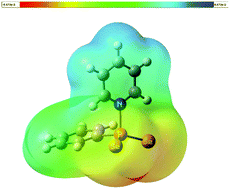
Chem. Commun., 2014,50, 6214-6216
https://doi.org/10.1039/C4CC01073F
An ebselen like catalyst with enhanced GPx activity via a selenol intermediate
Benzamide ring-substituted, quinine-derived ebselen analogue is synthesized which exists in selenol form upon addition of PhSH. It catalyses oxidation of PhSH with H2O2 faster (103-fold) than ebselen.
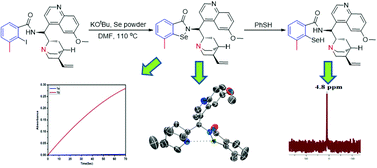
Org. Biomol. Chem., 2014,12, 1215-1219
https://doi.org/10.1039/C4OB00027G
Anti-Markovnikov hydrophosphoroselenoylation of alkenes using phosphorodiselenoic acid esters leading to the formation of phosphonoselenoic acid esters
Phosphorodiselenoic acid esters with a binaphthyl group were reacted with alkenes in the presence of Bu3SnH and AIBN to give phosphonoselenoic acid esters in moderate to good yields.

Chem. Commun., 2013,49, 9675-9677
https://doi.org/10.1039/C3CC45912H
An efficient route for the synthesis of phosphorus–selenium macro-heterocycles
[PhP(Se)(μ-Se)]2 (Woollins' reagent, WR) with disodium alkenyl-diols and dibromoalkanes are able to construct a series of unusual nine- to fifteen-membered organoselenophosphorus macrocycles bearing the O–P–Se–Cn–Se–P–O linkage or the O–P–Se–Cn–O–P–Se linkage.
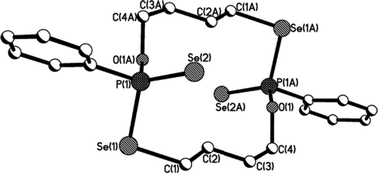
Chem. Commun., 2013,49, 2619-2621
https://doi.org/10.1039/C3CC40515J
Controlling Pt nanoparticle formation through Se⋯Pt interactions on the electrode surface
Interactions between the electrode surface and the transition metal during the initial step of metal nanoparticle formation can be utilized to control the formation and size of metal nanoparticles deposited on a conducting surface.
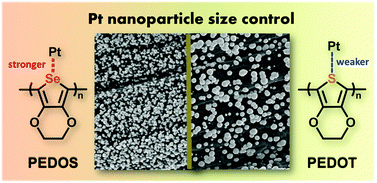
Chem. Commun., 2012,48, 6776-6778
https://doi.org/10.1039/C2CC30824J
Planar P6E6 (E = Se, S) macrocycles incorporating P2N2 scaffolds
The 15-membered rings [(tBuN)P(μ-NtBu)2P(NtBu)(μ-E–E)]3 (E = Se, S) are comprised of planar P6E6 motifs stabilised by perpendicular P2N2 rings.
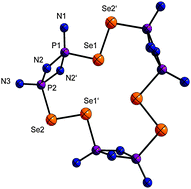
Chem. Commun., 2012,48, 6346-6348
https://doi.org/10.1039/C2CC32809G
Photoluminescent selenospirocyclic and selenotetracyclic derivatives by domino reactions of amines and imines
Novel photoluminescent selenospirocyclic and selenotetracyclic compounds, stabilized by intramolecular secondary Se⋯O interactions with an ortho-nitro group, have been accessed successfully through domino reactions of amines and imines, respectively.
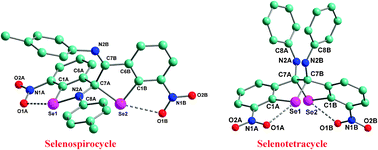
Chem. Commun., 2011,47, 7221-7223
https://doi.org/10.1039/C1CC12152A
Thermal reaction of a (hydrido)(selenolato)platinum(II) complex having a dibenzobarrelenyl group leading to three cyclometalations
The thermal reaction of a (dibenzobarreleneselenolato)(hydrido)platinum(II) complex gave two four-membered selenaplatinacycles by syn-hydroplatination and a vinylic C–H activation and a five-membered one by an aromatic C–H activation.
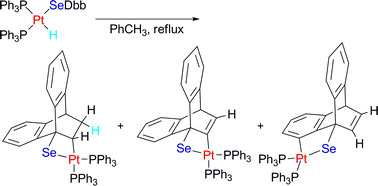
Dalton Trans., 2010,39, 6181-6183
https://doi.org/10.1039/C0DT00483A
Novel carbon -centred reactivity of [(H)C(PPh2Se)2 ]− in the formation of structurally diverse Sn(IV) , Te(IV) and Hg(II) complexes of the triseleno ligand [(Se)C(PPh2Se)2]2–
The 2 : 1 reactions between TMEDA·Li[(H)C(PPh2Se)2] and MCl2 afforded the homoleptic complexes, {M[(H)C(PPh2Se)2]2}, which undergo a selenium/hydrogen exchange at the carbon centre to yield the dianionic triseleno ligand in {Mn[(Se)C(PPh2Se)2]2} (n = 1, M = Sn, Te; n = 2, M = Hg).
![Graphical abstract: Novel carbon-centred reactivity of [(H)C(PPh2Se)2]− in the formation of structurally diverse Sn(iv), Te(iv) and Hg(ii) complexes of the triseleno ligand [(Se)C(PPh2Se)2]2–](/en/Image/Get?imageInfo.ImageType=GA&imageInfo.ImageIdentifier.ManuscriptID=B923910C&imageInfo.ImageIdentifier.Year=2010)
Chem. Commun., 2010,46, 1431-1433
https://doi.org/10.1039/B923910C
Poly(cyclopenta[c]selenophene) : a new polyselenophene
Cyclopenta[c]selenophene-(CH2OMe)2 has been synthesized by a new synthetic approach and successfully electrochemically polymerized. PCPS showed well-defined spectroelectrochemistry, a low band gap and good stability in the oxidized state. Calculations predicted a planar structure for PCPS.
![Graphical abstract: Poly(cyclopenta[c]selenophene): a new polyselenophene](/en/Image/Get?imageInfo.ImageType=GA&imageInfo.ImageIdentifier.ManuscriptID=B915826J&imageInfo.ImageIdentifier.Year=2010)
Chem. Commun., 2010,46, 1168-1170
https://doi.org/10.1039/B915826J
Hydrolysis of 2-phenylazophenyltellurium trihalides: isolation of an unprecedented homometallic, discrete heptanuclear organotellurium oxide cluster
Alkaline hydrolysis of (2-phenylazophenyl)tellurium trihalides gave an intramolecularly stabilized homometallic, heptanuclear organotellurium oxide cluster R6Te7O11 (4) in good yield.

Chem. Commun., 2010,46, 1130-1132
https://doi.org/10.1039/B921785A
Diazabutadiene complexes of selenium as Se2+ transfer reagents
Alkyl and aryl substituted diazabutadiene ligands are shown to support a highly electrophilic “Se2+” synthon, which can be utilized in ligand exchange reactions to generate Se centred dicationic coordination complexes.

Chem. Commun., 2010,46, 1041-1043
https://doi.org/10.1039/B917841D
N-Triphenylboryl- and N,N′-bis(triphenylboryl)benzo-2,1,3-telluradiazole
Triphenylborane adducts of benzo-2,1,3-telluradiazole are isoelectronic and isostructural analogues of N-alkyl-substituted telluradiazolyl cations.
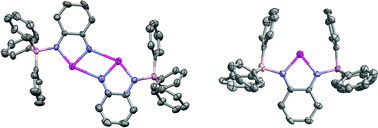
Chem. Commun., 2009, 4043-4045
https://doi.org/10.1039/B904713A
Telluroselenophosphonium ions: their unusual soft–soft interactions with iodotellurate anions
The formally uncharged tellurium atom from the first telluroselenophosphonium cation [tBu(iPr)2(p-TolTeSe)P]+ behaves as a soft acceptor towards the central tellurium atom of a diiodotellurate(II) anion [p-TolTeI2]−, exhibiting a novel type of Te(anion)→ Te(cation) donor–acceptor interaction involving two orthogonal 3c–4e systems.
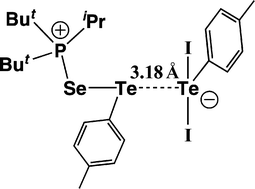
Dalton Trans., 2007, 3483-3485
https://doi.org/10.1039/B708370J
The effect of selenium incorporation on the bandwidth and conductivity of neutral radical conductors
The first example of an undimerized π-stacked bis-1,2,3-thiaselenazolyl radical displays improved bandwidth and conductivity relative to an isostructural bis-1,2,3-dithiazolyl.

Chem. Commun., 2005, 5745-5747
https://doi.org/10.1039/B511648A
Enantiomerically pure P-chiral phosphinoselenoic chlorides: inversion of configuration at the P-chirogenic center in the synthesis and reaction of these substances
Optically active P-chiral phosphinoselenoic chlorides were successfully synthesized by reacting optically active phosphinoselenoic acid salts with oxalyl chloride. The chloride was converted to a phosphinoselenothioic acid salt with high ee.

Chem. Commun., 2005, 4077-4079
https://doi.org/10.1039/B507755A
Synthesis of primary-alkyl selenols and selenides from primary-alkyl thiols involving diphenyl sulfonium salts
Hexyl thiol has been transformed to hexyl selenol and related selenides and selenocyanate by substitution of the corresponding hexyldiphenylsulfonium tetrafluoroborate with selenium nucleophiles.

Chem. Commun., 2005, 2167-2168
https://doi.org/10.1039/B418026G
Vapour deposited films of quinoidal biselenophene and bithiophene derivatives as active layers of n-channel organic field-effect transistors
n-Channel OFETs using oligoselenophane- and oligothiophene-based semiconductors as active layers have been successfully fabricated, and the field-effect mobilities for the selenophane-based compounds are found to be higher than those for the thiophene analogues.

J. Mater. Chem., 2004,14, 1367-1369
https://doi.org/10.1039/B401209G
First linear alignment of five C–Se⋯O⋯Se–C atoms in anthraquinone and 9-(methoxy)anthracene bearing phenylselanyl groups at 1,8-positions
Five Ci–Se⋯O⋯Se–Ci atoms in

Chem. Commun., 2003, 124-125
https://doi.org/10.1039/B209261A
Functionalizing the surface of II–VI clusters: redox active centres on the adamantoid complex [Cd4Cl4{μ-(SeC5H4)Fe(C5H5)}6]2−
Trimethylsilylselenoferrocene 1 has been prepared in good yield from sodium ferrocenylselenolate. The reagent 1 is used as for the synthesis [Cl4Cd4{μ2-Se(C5H4)Fe(C5H5)}6]2−2 (shown), a Cd4Se6 adamantoid cluster with six surface ferrocenyl groups.
![Graphical abstract: Functionalizing the surface of II–VI clusters: redox active centres on the adamantoid complex [Cd4Cl4{μ-(SeC5H4)Fe(C5H5)}6]2−](/en/Image/Get?imageInfo.ImageType=GA&imageInfo.ImageIdentifier.ManuscriptID=B302829A&imageInfo.ImageIdentifier.Year=2003)
Chem. Commun., 2003, 1398-1399
https://doi.org/10.1039/B302829A
Dissociative
Chem. Commun., 2001, 2448-2449
https://doi.org/10.1039/B107688B
Model study on trapping of protein selenenic acids by utilizing a stable synthetic congener
Model studies on the trapping reaction of protein selenenic acids were carried out with a stable primary-alkyl model compound.

New J. Chem., 2019,43, 6830-6833
https://doi.org/10.1039/C9NJ01072F
Diselenolane-mediated cellular uptake
Selenophilicity, minimized dihedral angles, acidic selenols, multitarget hopping: cytosolic delivery with 1,2-diselenolanes outperforms 1,2-dithiolanes, by far.
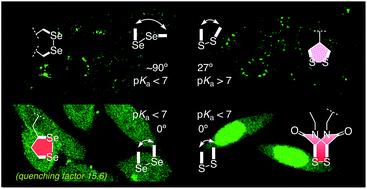
Chem. Sci., 2018,9, 1860-1866
https://doi.org/10.1039/C7SC05151D
Accessing human selenoproteins through chemical protein synthesis
The human body contains 25 selenoproteins, but challenges in their preparations have prevented biological characterizations thus far. Here we report the first total chemical syntheses of two human selenoproteins, selenoprotein M (SELM) and selenoprotein W (SELW).
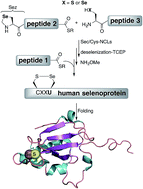
Chem. Sci., 2017,8, 1922-1926
https://doi.org/10.1039/C6SC04123J
Diaryldichalcogenide radical cations
One-electron oxidation of diaryldichalcogenides is the key to the preparation of the corresponding radical cations.

Chem. Sci., 2015,6, 497-504
https://doi.org/10.1039/C4SC02964J
Investigation on photo-induced charge separation in CdS/CdTe nanopencils
CdS/CdTe nanopencils were synthesized via anion exchange and the effect of the geometry on the carrier dynamics was investigated.
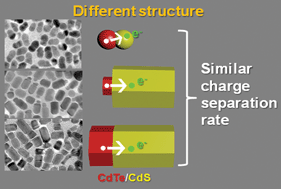
Chem. Sci., 2014,5, 3831-3835
https://doi.org/10.1039/C4SC00635F
Fast and easy conversion of ortho amidoaryldiselenides into the corresponding ebselen-like derivatives driven by theoretical investigations
The in silico predicted Se⋯N interaction on amidoarylselenenyl iodides has been experimentally exploited for the efficient synthesis of N-substituted benzoisoselenazol-3(2H)-ones, benzoisothiazol-3(2H)-ones and ebselen, recently reported as potent antiviral agent against Sars-Cov2.
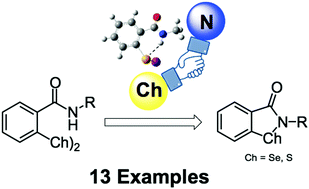
New J. Chem., 2020,44, 9444-9451
https://doi.org/10.1039/D0NJ01605E
Acylselenoureato bis(chelates) of lead: synthesis, structural characterization and microwave-assisted formation of PbSe nano- and microstructures
Three lead(II) bis(acylselenoureato) complexes were prepared by reaction of the respective acylselenourea compounds with Pb(OAc)2. One of these lead complexes was converted into PbSe nano- and microstructures by microwave-assisted synthesis.
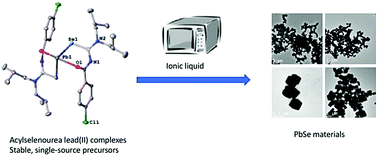
New J. Chem., 2020,44, 7719-7726
https://doi.org/10.1039/D0NJ01433H
Non-covalent bridging of bithiophenes through chalcogen bonding grips
In this work, chalcogen functionalized dithiophenes, equipped on both extremities with chalcogen-bonding recognition heterocycles, have been prepared following two synthetic pathways.

New J. Chem., 2020,44, 6732-6738
https://doi.org/10.1039/C9NJ06202E
Sequential oxidations of phenylchalcogenides by H2O2: insights into the redox behavior of selenium via DFT analysis
The biological activity of sulfur and selenium, despite their similarity, shows some remarkable differences that have been recognized in many different scenarios.
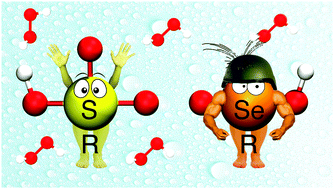
New J. Chem., 2020,44, 6724-6731
https://doi.org/10.1039/C9NJ06449D
Synthesis, photophysics and biomolecule interactive studies of new hybrid benzo-2,1,3-thiadiazoles
New hybrid molecules containing benzo-2,1,3-thiadiazole, benzofuran and arylselanyl moieties were synthesized and their photophysics and biomolecule interactive studies were performed.
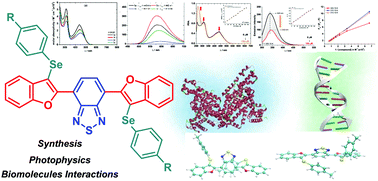
New J. Chem., 2020,44, 2768-2780
https://doi.org/10.1039/C9NJ05932F
A combined experimental and theoretical study of bimetallic bis- and tris-homocubane analogues
Various bimetallic bis- and tris-homocubane analogues of group 9 transition metals have been isolated and structurally characterized employing Li[BH2E3] (E = S or Se).
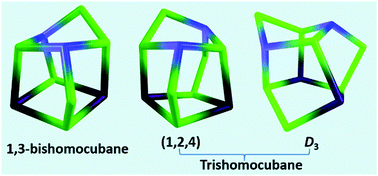
New J. Chem., 2020,44, 674-683
https://doi.org/10.1039/C9NJ05117A
A novel methodology for the synthesis of condensed selenium heterocycles based on the annulation and annulation–methoxylation reactions of selenium dihalides
A novel methodology for accelerating the annulation was developed based on the reactions of selenium dihalides in the presence of alcohols.
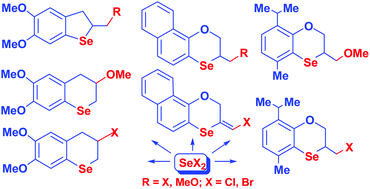
New J. Chem., 2019,43, 18476-18483
https://doi.org/10.1039/C9NJ04707G
Design, synthesis and isolation of a new 1,2,5-selenadiazolidyl and structural and magnetic characterization of its alkali-metal salts
A new electron acceptor is synthesized and reduced into its radical-anion isolated in the form of two salts with different structures and magnetic properties.
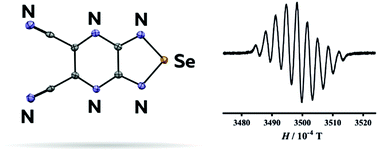
New J. Chem., 2019,43, 16331-16337
https://doi.org/10.1039/C9NJ04069B
Nature of the E⋯E′ interactions (E, E′ = O, S, Se, and Te) at naphthalene 1,8-positions with fine details of the structures: experimental and theoretical investigations
The nature of E⋯E′ in 1-RE–8-R′E′C10H6 (E/E′ = O, S, Se and Te) is clarified with the QTAIM approach and NBO analysis, after structural determinations.
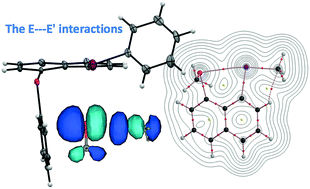
New J. Chem., 2019,43, 14224-14237
https://doi.org/10.1039/C9NJ02198A
Synthesis and characterisation of [Cu4In(PPh3)3SePh(μ-SePh)3(μ3-SePh)3], and its application as a precursor of a sensitizer for a photocatalyst
An active and robust photocatalyst for water splitting.
![Graphical abstract: Synthesis and characterisation of [Cu4In(PPh3)3SePh(μ-SePh)3(μ3-SePh)3], and its application as a precursor of a sensitizer for a photocatalyst](/en/Image/Get?imageInfo.ImageType=GA&imageInfo.ImageIdentifier.ManuscriptID=C9NJ02046B&imageInfo.ImageIdentifier.Year=2019)
New J. Chem., 2019,43, 14196-14201
https://doi.org/10.1039/C9NJ02046B
Copper complexes and carbon nanotube–copper ferrite-catalyzed benzenoid A-ring selenation of quinones: an efficient method for the synthesis of trypanocidal agents
A-ring selenation of naphthoquinones and anthraquinones is reported. The reaction proceeds in the presence of a copper source, and provides an efficient and general method for preparing selenium-based quinones with trypanocidal activity.
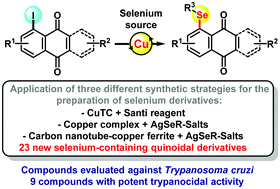
New J. Chem., 2019,43, 13751-13763
https://doi.org/10.1039/C9NJ02026H
Free radical induced selenoxide formation in isomeric organoselenium compounds: the effect of chemical structures on antioxidant activity
Formation of selenoxides improves the antioxidant activity of organoselenium compounds and should be considered as an important marker in the design of new selenium based antioxidants.
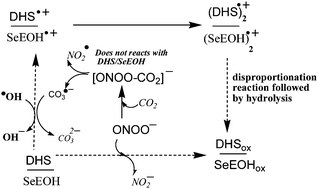
New J. Chem., 2019,43, 13357-13362
https://doi.org/10.1039/C9NJ02227A
Reactivity of bis[{2,6-(dimethylamino)methyl}phenyl]telluride with Pd(II) and Hg(II): isolation of the first Pd(II) complex of an organotellurenium cation as a ligand
The first complex of an organotellurenium cation as a ligand with Pd(II) is reported.
![Graphical abstract: Reactivity of bis[{2,6-(dimethylamino)methyl}phenyl]telluride with Pd(ii) and Hg(ii): isolation of the first Pd(ii) complex of an organotellurenium cation as a ligand](/en/Image/Get?imageInfo.ImageType=GA&imageInfo.ImageIdentifier.ManuscriptID=C9NJ02469G&imageInfo.ImageIdentifier.Year=2019)
New J. Chem., 2019,43, 13225-13233
https://doi.org/10.1039/C9NJ02469G
Structural diversity of the complexes of monovalent metal d10 ions with macrocyclic aggregates of iso-tellurazole N-oxides
Iso-tellurazole N-oxides yield a remarkable variety of structures with coinage-metal monocations.

New J. Chem., 2019,43, 12601-12608
https://doi.org/10.1039/C9NJ02217A
The reaction of phenoxatellurine with single-electron oxidizers revisited
Baking Pancakes: Dicationic products of the single-electron oxidation of phenoxatellurine.
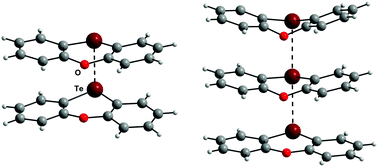
New J. Chem., 2019,43, 12754-12766
https://doi.org/10.1039/C9NJ02401H
Sulphur–sulphur, sulphur–selenium, selenium–selenium and selenium–carbon bond activation using Fe3(CO)12: an unexpected formation of an Fe2(CO)6 complex containing a μ2,κ3-C,O,Se-ligand
Four diiron hexacarbonyl-complexes containing dithiolato (5), diselenolato (6), selenolato-thiolato (7) and μ2,κ3-C,O,Se-ligands (8), respectively have been prepared as [FeFe]-hydrogenase mimics.
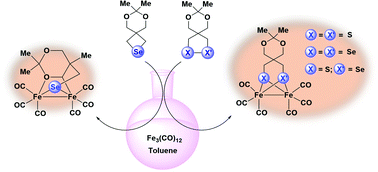
New J. Chem., 2019,43, 12580-12593
https://doi.org/10.1039/C9NJ02642H
Isomorphic substitution in molecular crystals and geometry of hypervalent tellurium: comments inspired by a case study of RMeTeI2 and [RMe2Te]+I− (R = Ph, Fc)
Unusual isomorphic substitution in the crystals of [FcMe2Te]+I− with an admixture of Te–I ionized [FcMeTeI+]I− supports the 3c-4e as a general, seamless bonding model for the hypervalent tellurium in both the isolated molecules and crystals.
![Graphical abstract: Isomorphic substitution in molecular crystals and geometry of hypervalent tellurium: comments inspired by a case study of RMeTeI2 and [RMe2Te]+I− (R = Ph, Fc)](/en/Image/Get?imageInfo.ImageType=GA&imageInfo.ImageIdentifier.ManuscriptID=C9NJ02318F&imageInfo.ImageIdentifier.Year=2019)
New J. Chem., 2019,43, 12225-12232
https://doi.org/10.1039/C9NJ02318F
About this collection
The chemistry of selenium and tellurium is experiencing continuous and exponential growth thanks to its implication in many research fields spanning from fundamental organic/inorganic/bio-chemistry, to material science, biology, pharmacology, medicine, agriculture and environmental science.
The International Conference on the Chemistry of Selenium and Tellurium (ICCST), next year at its 14th edition, has witnessed and supported the growth of this research area since 1971, offering an International forum for discussing cutting-edge results. Interest in the chemistry of these two elements has been sustained by the RSC publishing several reviews and monographs over the past decade.
This thematic web collection on all facets of the chemistry of selenium and tellurium will give an open updated snapshot of the research on these two elements as multidisciplinary science, offering unique opportunities of interactions of researchers working in different areas, and it will celebrate ICCST as recognized platform of discussion.
The collection, Guest Edited by Vito Lippolis and Claudio Santi, will contain papers published in the past 20 years by chemists who have attended ICCST, and new papers published in NJC by the end of 2019.